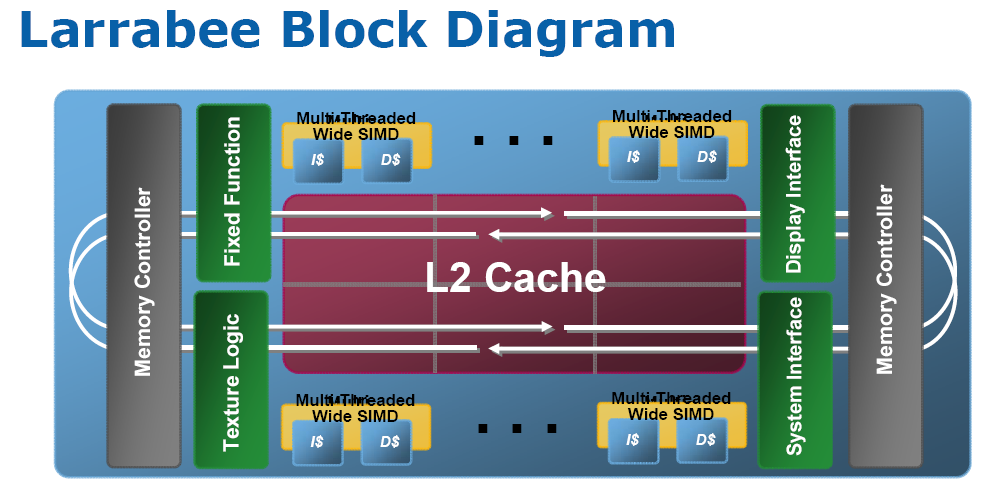Intel Kills Off Larrabee Discrete Graphics, For Real
Intel gives an update on the graphics work going on at the chipmaker.
Intel's graphical part known as Larrabee never came to fruition. Last year we learned that Intel missed some key milestones in its plan for Larrabee and as a result it had to shelve the project. Intel's Bill Kircos wrote in a blog post an update on the company's graphics-related programs.
Kircos began with an overview of Intel's current graphics offerings, notably the Intel HD part that's paired with the Westmere processors now and the ability to send a wireless display signal to an external box hooked up to an HDTV.
"Intel's processor graphics will continue to be enhanced - with more surprises - in our 2011 Intel Core processor family, code-named Sandy Bridge," he added.
Kircos then ran through the three visual computing efforts that the company is still paying attention to: integrated processor graphics such as the Intel HD, smaller graphics for Atom and other System on Chip designs, and a many-core, programmable Intel architecture that Larrabee was set out to be.
Now for the updates on Intel's current work on graphics:
1. Our top priority continues to be around delivering an outstanding processor that addresses every day, general purpose computer needs and provides leadership visual computing experiences via processor graphics. We are further boosting funding and employee expertise here, and continue to champion the rapid shift to mobile wireless computing and HD video - we are laser-focused on these areas. 2. We are also executing on a business opportunity derived from the Larrabee program and Intel research in many-core chips. This server product line expansion is optimized for a broader range of highly parallel workloads in segments such as high performance computing. Intel VP Kirk Skaugen will provide an update on this next week at ISC 2010 in Germany. 3. We will not bring a discrete graphics product to market, at least in the short-term. As we said in December, we missed some key product milestones. Upon further assessment, and as mentioned above, we are focused on processor graphics, and we believe media/HD video and mobile computing are the most important areas to focus on moving forward. 4. We will also continue with ongoing Intel architecture-based graphics and HPC-related R&D and proof of concepts.
The takeaways from this list are:
Get Tom's Hardware's best news and in-depth reviews, straight to your inbox.
- Intel's IGPs will continue to get faster, with the next leap happening with Sandy Bridge.
- Intel is applying some of its Larrabee work to the HPC sector.
- There won't be a Larrabee graphics card that will compete against Nvidia or AMD/ATI parts any time soon.
-
Pei-chen LArrabee don't have to be GTX480 or 5870 fighter. A 5770 level video card with decent price + driver would still be welcomed in the market.Reply -
nforce4max Good riddance, they could have at the least put out something even if it SUCKED that was fair priced would have been better than this. I still got a i740 agp and would have been nice to have added another discrete Intel gpu to my collection. 12 years and nothing new.Reply -
HalJordan I really thought it was officially dead months ago...I was not aware that Intel considered it "shelved." I suppose this announcement equates to putting a bullet into the head of a wounded animal, lying on the ground, howling in pain, and yearning for a quick death. I never really had high hopes for Larrabee; the idea was a pipe dream at best, and smacked of insanity at worst. Competing with likes of ATI and Nvidia in the GPU market is just not feasible, unless Intel bought out a ton of talent from their competitors. Apparently, Intel did wise up and is sticking with dominating the processor market.Reply -
jerreece Replyin our 2011 Intel Core processor family, code-named Sandy Bridge
LOL Does that mean the bottom falls out? Not an inspiring code name. ;) -
ta152h It's always good when the plague known as x86 doesn't encroach on any new areas. Why Intel thought an instruction set considered poor 32 years ago, made sense for a modern GPU escaped a lot of people, considering compatibility wouldn't be such an important consideration there.Reply
They'd be better off going with a clean, efficient instruction set if they ever try to get into that market again. How could they expect to compete with well-established players with that handicap?
I still don't know exactly what "we are focused on processor graphics, and we believe media/HD video and mobile computing are the most important areas to focus on moving forward" means. Processor graphics means the IGP that comes with the processor now? The other stuff also means that, even though discrete cards do that too? That's got to be it, but it's not too clear, really.
-
bujuki Does it mean that there will be no ray-tracing game in the near future? Quite sad if it's true, I really looked forward to see that and the day when programmer find more and more new rendering techniques (and of course read those in Tomshardware ^^).Reply -
mowston Intel's Westmere IGP is already better than AMD's IGP, and competes well with low end discrete graphics. So with Sandy Bridge, Intel will probably be much better than AMD and Nvidia's IGP and compete with their future low-ends. Maybe Intel will actually make something that competes with their mid-range.Reply -
invlem Honestly they stuck graphics into a CPU that let's me play 1080p and bitstream TrueHD and DTS MA without the need for disrete graphics or a special sound card.Reply
I'm happy :) larrabee or not

